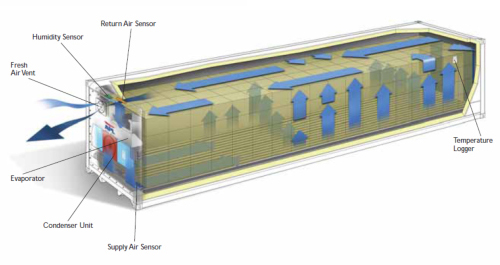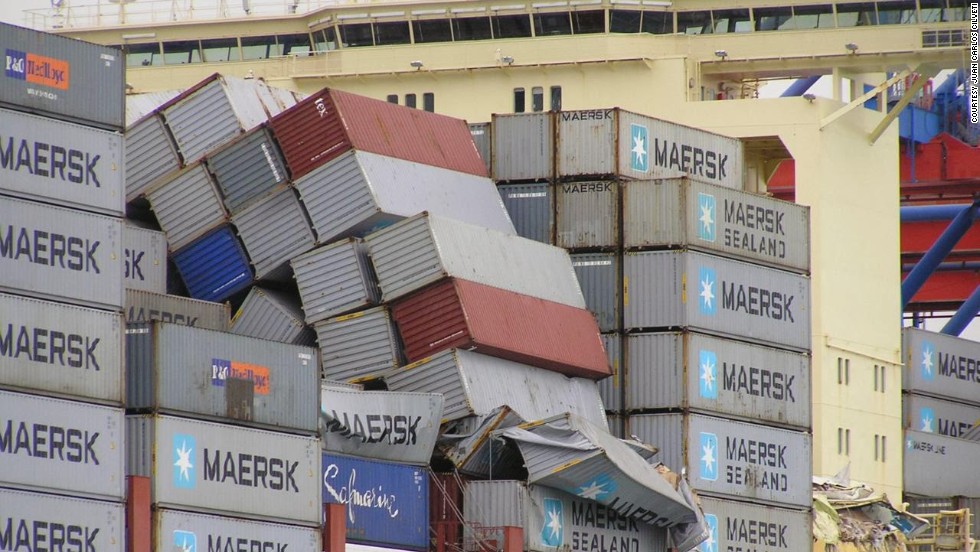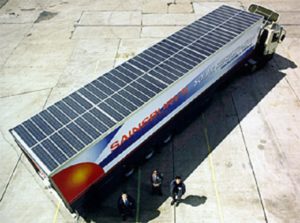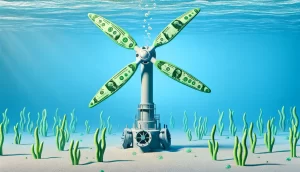I can purchase bananas from Peru or pineapples from Hawaii just by walking over to my local Trader Joe’s. What makes this possible? The reefer. No, not weed, the refrigerated container. But this convenience comes at a cost. All of the reefers in world consume as much energy as a small state and the vast majority are powered by diesel generators emitting millions of tons of CO2 each year. In this post I’ll investigate an alternative solution to our reefer woes, the solar reefer.
One Box to Rule Them All
For those of you who are unfamiliar with a shipping container, imagine a big rectangular box. That’s pretty much all there is to it. But each box is the same as the next, they’re all the same in fact. This simple idea from Malcom McLean revolutionized the transportation industry in the 1950s and 60s. All of a sudden cargo had become standardized and this made loading and unloading a big cargo ship much more efficient.
Today, containers do come in different shapes and sizes, but most are either a twenty or a forty-foot long variant. These are what you most often see being towed by trucks on the highway. These boxes are so prevalent that they’ve even given rise to their own metric, the Twenty-foot Equivalent Unit (TEU) and the Forty-foot Equivalent Unit (FEU), respectively. For example, a containership rated for 20,000 TEU, can carry 20,000 twenty-foot containers.

Initially, only dry non-perishable goods were transported in containers, but by the 1970’s a new type of container with an attached refrigeration unit was introduced. These refrigerated containers, or reefers, enabled the contents of the container to be kept at a controlled temperature for transport. Shipping kangaroo burgers from Australia to California had never been easier.
Reefer Madness
The refrigeration system for a reefer is very similar to the system in your household refrigerator, just a little more heavy-duty. In very basic terms, a refrigerant is circulated around a close-loop system, exchanging heat between the inside and outside of the box, ideally keeping the inside of the box cool.

The energy to run the refrigeration system’s compressor, fan, and electronics needs to come from somewhere. On ships energy comes from the ship’s electrical system (powered by steam or diesel generators); in container yards energy comes from the local grid; and on long-haul trucks or railcars energy comes from small diesel generators, or gen-sets, attached to the box. For all these cases, fossil fuels are the primary energy supplier.
In 2016 there was an estimated 2.5 million TEU of reefers in the container fleet, but let’s assume that only 40% of them were actually in use, call it 1 million TEU of reefers [1] [2] [3]. How much energy do 1 million reefers use? Good question, let’s work it out.
Energy consumption for a refrigerated container depends on a bunch of different factors (set-point temperature for the cooled space, ambient conditions, system efficiency, etc.), but the “Container Handbook” [4] suggests an average value of 3,600 W per TEU which sounds good to me.
Next, let’s assume that the reefer is carrying cargo 200 days a year and that the refrigeration system is only running for 50% of the time, or 12 hours each day. So by the power of higher mathematics, reefers consumed an estimated 8.6 TWh of energy in 2016. As a point of reference, that’s more than is consumed by the entire state of Alaska [5]. As Keanu Reeves would say, “Woah.”

The majority of this energy comes from diesel engines while the reefers are being transported on ships, railcars, or trucks. So if we assume an emission factor of 1.27 kg CO2/kWh [6] reefers were responsible for almost 11 million metric tons of CO2 emissions last year. Talk about hot-boxing.
Does it have to be this way, or can we offset some or all of these emissions using some solar panels attached to the reefer? Let’s green a reefer.
(Note, for more info on reefers and the cold supply chain, check out this podcast from 99% Invisible)
Greening the Reefer
Using the assumptions above, I’m estimating a reefer consumes about 43 kWh each day. Next, we’ll use a “peak-hours” approach and an average solar insolation of 5 peak sun hours falling on our solar reefer each day (good explanation of peak-hour concept here). So on average the solar array on this hypothetical reefer would need to output 8.6 kWh, but we’ll add a 15% buffer on top of that to account for system losses, which brings us to about 10 kWh as the needed output for the array.
Lets say we use this LG solar panel rated for 300 W, then that would mean we need 34 panels. Each panel is 1.6 m by 1 m, so we’d need 54.4 square meters of sun receiving surface area on the reefer. A single TEU container has an available surface area of 58.8 square meters, not including the bottom. Since it’s impossible for the sun to hit every side of a container at once, powering an average reefer entirely by solar is just not possible. Unless we change the energy consumption of the system that is.
Since there is no sense in covering the entire reefer in solar, let’s consider just using the top. A single TEU container has roughly 14 square meters of surface area available, meaning we could fit eight 300 W panels capable of a maximum 2.4 kW, or 4.8 kW on a FEU container. This is about 25% of the energy needed, that ain’t nothing! If all of those 1 million reefers in operation were to adopt just a solar top, we could be avoiding more than 15,000 metric tons of CO2 emissions each year.
How much would it cost? Let’s throw some numbers around. NREL estimates that the mean install cost for a commercial photovoltaic system to be about $2.10 per Watt in 2016 [7]; let’s just call it $2 even. This means a solar top for a FEU container would cost about $9,600. The average cost of a regular 40-foot reefer is $30,000 [8], so we’re looking at nearly a 30% mark-up. The estimated fuel costs for a regular reefer are around $4,000 per year [9] [10], so if we can knock off roughly 25% of that through our solar top we’d be looking at an approximate nine-year payback, all else being equal. Not great, but not horrible neither.
Of course this is all a rough calculation and subject to variables such as efficiencies, temperatures, insulation, shading, and weather. I’m also not considering the battery storage system that we’d want to incorporate as well. Take this all in with a large grain of sea salt.
A Solar Reefer in its Natural Habitat
Containers are meant to be stacked on top of one another. A stacked container, hidden within other container stacks, is not going to receive a plethora of sunlight. Containers have a rough life. Tools, stowage gear, and other heavy equipment are constantly bumping into and falling onto containers, so it would be hard to imagine a fragile solar array lasting very long. Then there is the salt spray and the corrosion from the marine environment which leads to a host of other problems.

Things aren’t all doom and gloom for solar reefer adoption. Reefer containers use the most energy when they are baking in the sun – which is exactly when solar panels perform best. Ships often do not have enough electrical outlets for all of the reefers that they load on the ship, meaning some have to share or simply go without power for the transit [8]. A solar system would help with this, providing some small level of power during the voyage. Containers are standardized which means a solar array would be interchangeable with other boxes, increasing system recycling and cutting install costs.

A solar reefer isn’t a novel idea. Sandia National Labs did a feasibility study in 2001, found here. The author did a much more thorough analysis, (and if you have the time I encourage you read it), but came to a similar conclusion: we’re not quite there yet, but with some design changes it may be worth the effort.
Reefers have enabled a global supply chain of perishable goods, but it comes at a high-energy cost. A solar reefer could help reduce this cost, but with current technology it won’t eliminate it. As solar panel performance and strength improves it’s worth revisiting. Soon a solar reefer may shift from a mere novelty to a new standard.
References
[1] World Shipping Council. [Internet]. Available from: http://www.worldshipping.org/about-the-industry/containers/global-container-fleet
[2] Container Services International. [Internet]. Available from: https://www.csiu.co/resources-and-links/world-container-fleet
[3] Billie Box. Facts About Shipping Containers. [Internet]. Available from: https://www.billiebox.co.uk/facts-about-shipping-containers/
[4] GDV. Container Handbook. [Internet]. Available from: http://www.containerhandbuch.de/chb_e/wild/index.html?/chb_e/wild/wild_08_01_02.html
[5] U.S. Department of Energy. State of Alaska Energy Sector Risk Profile. [Internet]. Available from: https://www.energy.gov/sites/prod/files/2015/05/f22/AK-Energy%20Sector%20Risk%20Profile.pdf
[6] Jakhrani AQ. Estimation of carbon footprints from diesel generator emissions. [Internet]. Available from: http://ieeexplore.ieee.org/document/6344193/)
[7] NREL. U.S. Solar Photovoltaic System Cost Benchmark: Q1 2016. [Internet]. Available from: http://www.nrel.gov/docs/fy16osti/67142.pdf
[8] Hylton S. Demand for Refrigerated Containers Heats Up. [Internet]. 2015 Available from: http://web.cds-worldwide.com/blog/demand-for-refrigerated-containers-heats-up
[9] California Environmental Protection Agency. Transport Refrigerators Technology Assessment. [Internet]. Available from: https://www.arb.ca.gov/msprog/tech/presentation/tru.pdf
[10] Electric Power Research Institute. Electric Refrigerated Container Racks: Technical Analysis. Case Study. Electric Power Research Institute; 2010
[11] APL. APL Services – Refrigerated Containers. [Internet]. 2016. Available from: https://www.apl.com/wps/portal/apl/!ut/p/z0/fY07D8IwEIN_TecLDyE6AhLhJVjbW6KjHOWgTdokqvj5RB2YEJvtz7IBoQC0NEhNUZylJvkSF-ai843Wy6nWc7VW-7Oan7bHXO9mEzgA_i-kBXn2Pa4AK2cjvyMU1DWmJbFBIpsxtbGRa6YSyNTDtTxKE8gE9oNUHL6B57uXmj1FvlXka_ebpNF0wD5A98LyA5QhkNk!/
[12] Masters GM. Renewable and Efficient Electric Power Systems. Hoboken (NJ): John WIley & Sons, Inc; 2004.
[13] National Renewable Energy Laboratory. Distributed Generation Renewable Energy Estimate of Costs. [Internet]. 2016]. Available from: http://www.nrel.gov/analysis/tech_lcoe_re_cost_est.html




